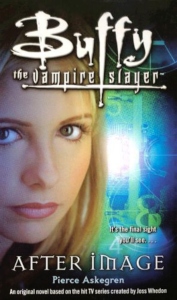In the early days of the “Buffy” books, the series released just a handful of Season 1-2 novels before staking out Season 3 as its primary storytelling ground. With the book series still popular enough to stay afloat after the end of the TV series, and with rumblings of Joss Whedon continuing the narrative someday in comics, the publishers made the smart decision to set most of the new books in Season 2. The first of these is “Afterimage” (January 2006), in which author Pierce Askegren walks the fine line of crafting a yarn that fits in Season 2 but keeps it small enough that we understand why the events aren’t referenced elsewhere – like “Bad Eggs” (2.12) in scope, but better in quality.
The most daring narrative choice is that Xander invites Jonathan to the drive-in movie festival with him, having been rejected by Buffy on the grounds that she’s slaying, Cordy on the grounds that she wouldn’t be caught dead there, and Goth girl Amanda on the grounds that she doesn’t date kids. I was waiting for him to ask Willow, but I guess he’s in “not noticing Willow” mode here.
Still, this is a nice portrayal of Xander trying to be nice to Jonathan and learning why a friendship won’t work out. He’s just a bit too Jonathan, if you know what I mean. Also, Jonathan dozes off during the all-night quadruple feature, one of many Sunnydale residents who fall asleep and don’t wake up, part of a scheme by the latest villain in town.
“Afterimage” is a small story, but I love the small moments, particularly Willow and Buffy researching in the public library archives when Angel pays them a visit, having arrived through the tunnels. A lot of research is also undertaken in Giles’ apartment. Askegren gets into the process of research more than any other “Buffy” story, but I don’t mind wallowing in the high school years (as long as they are the Scooby Gang’s and not mine). We also get a very amusing dinner scene between Joyce and Buffy, with the mother marveling at her daughter’s appetite.
Some nostalgia and humor also comes from the grindhouse nature of the fictional films that excite Xander, like “Mystery of Chainsaw Mansion,” “Caged Blondes” and “The Lonely Cheerleader.” Askegren was a year ahead of the nostalgia curve, as “Grindhouse” (a double feature of “Planet Terror” and “Death Proof”) hit theaters in 2007 and sparked a mini-resurgence in schlock actioners, among them “Machete” and “Hobo with a Shotgun.”
The book doesn’t dig into the details of Balsamo’s plan all that much, even by the time it’s over. It has something to do with foes who are there, and then aren’t there. Having recently done a “Ghostbusters” rewatch, I like the reference to ectoplasm, but I think more could’ve been done with this; maybe throw in some humor of an annoyed Buffy being covered in goo after every battle.

Still, Balsamo is an engaging baddie because Askegren makes him into an instantly likable presence. Even the moody Goth girl working at The Magic Box falls under the silver-haired man’s charms. Another nice wrinkle is that Balsamo is not in town because he’s drawn by the Hellmouth or because he wants to take a crack at the Slayer. Rather, he has been re-opening drive-ins for decades and sucking out moviegoers’ soul energies. It’s by accident that he stumbles across the Hellmouth and the Slayer in this latest stop.
“Afterimage” has to be placed on the timeline after “What’s My Line, Part Two” (2.10), because Xander and Cordelia are kissing, but before “Surprise” (2.13), as Angel is not Angelus yet. It’s probably before “Ted” (2.11) also, because Buffy mulls Joyce’s dating life without mentioning the horror of the robo-Ted experience. It feels like an earlier story, though, because no one mentions Kendra or the troubles with Spike and Dru, and at one point Giles says “It can’t possibly be Halloween yet.” So I suspect Askegren was thinking of this as a pre-“Halloween” (2.6) story but jumped the gun on Xander and Cordy.
That timeline quibble aside, Askegren – whose only other Buffyverse entry is a solid short story in “Angel: The Longest Night” – nicely eases readers back into the Season 2 period and has me excited about the possibilities for the books after this.
Click here for an index of all of John’s “Buffy” and “Angel” reviews.

